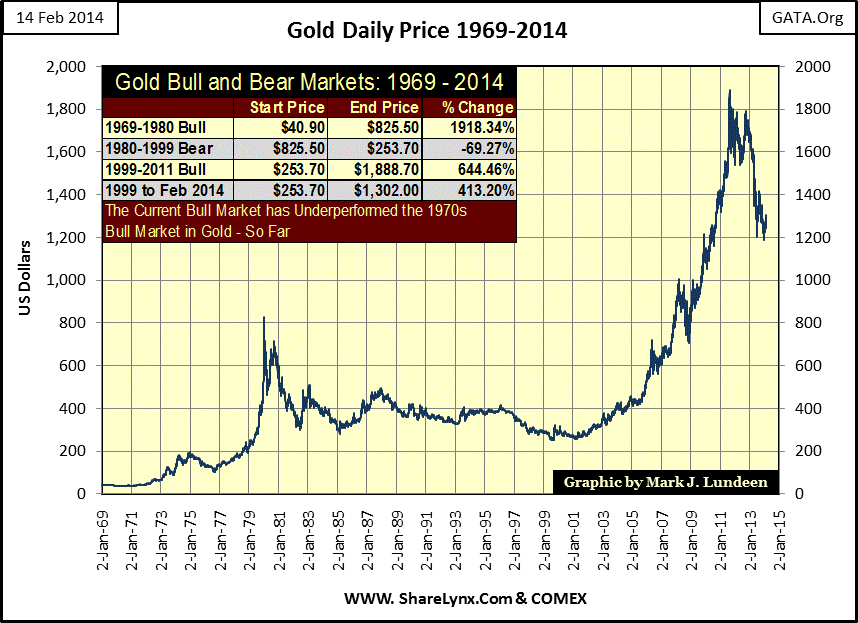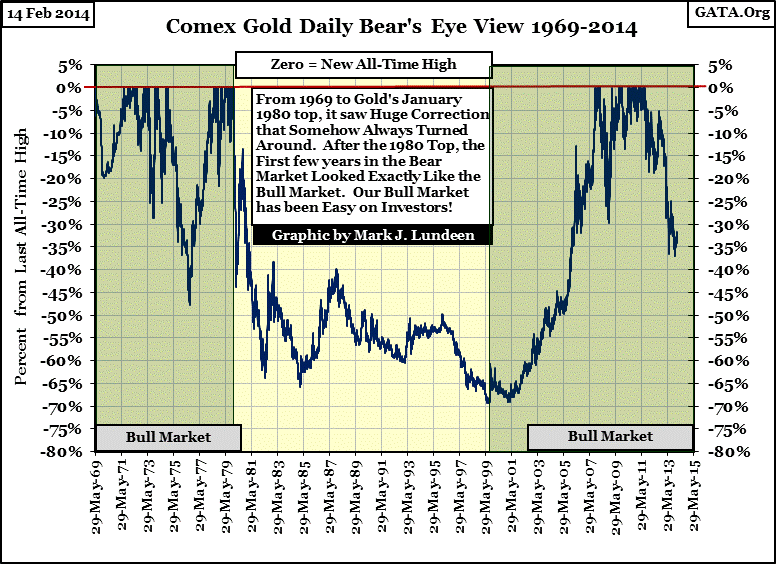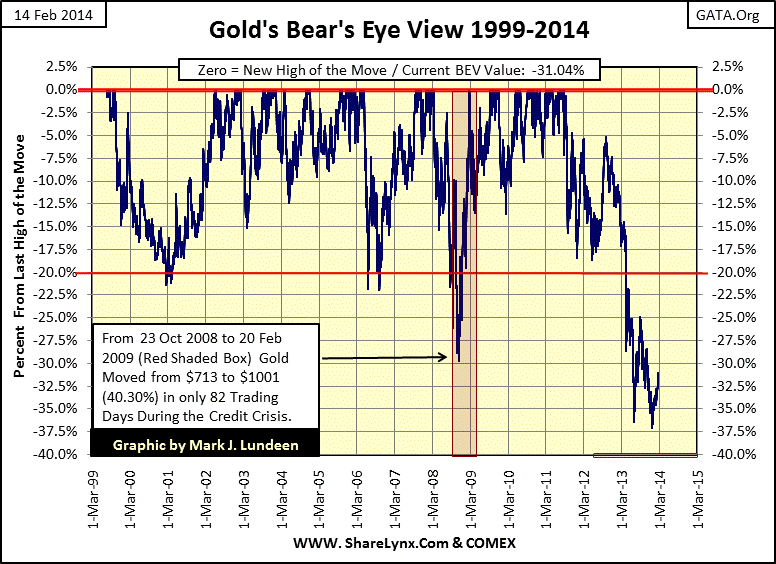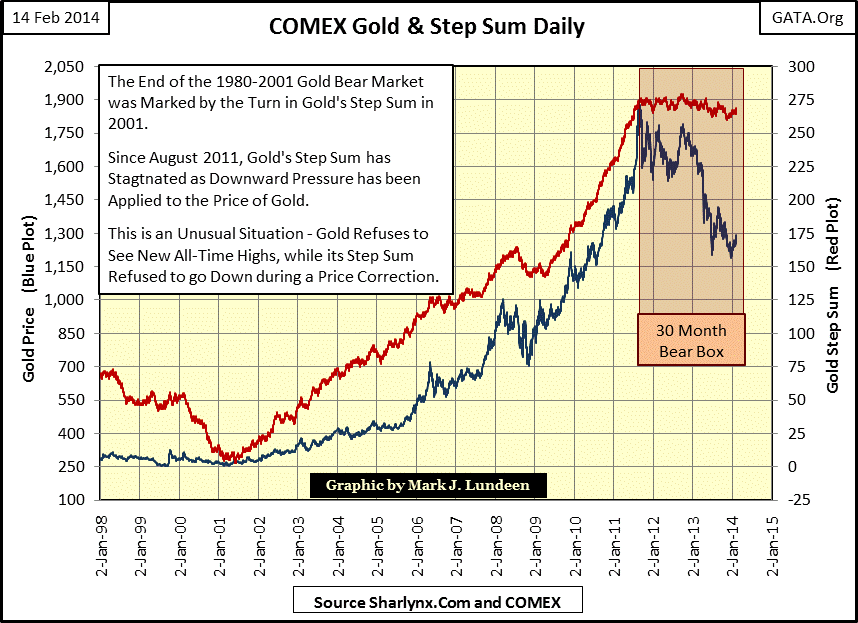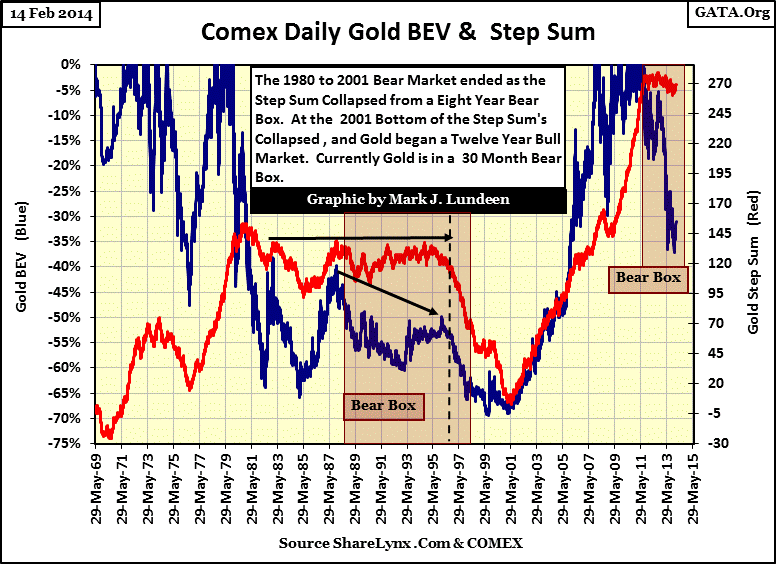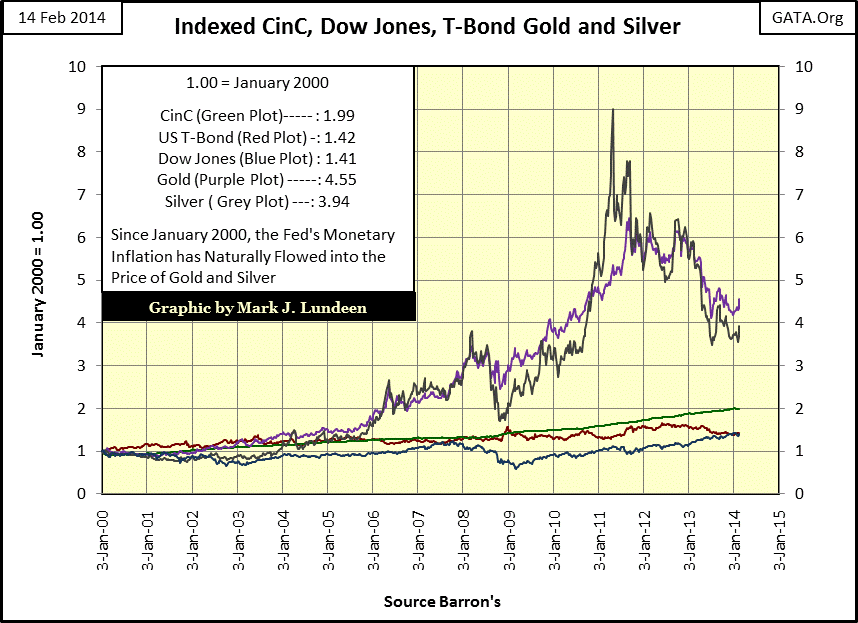Historical Perspective For The Current Gold Market
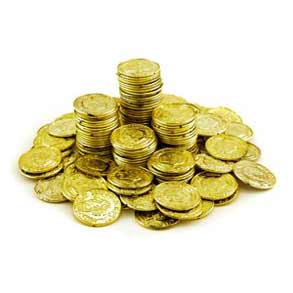
At the end of this week we are finally seeing some life in the precious metals markets. Since 2011, investors couldn’t be blamed for believing the price of gold and silver will only go down over time; not after Washington and Wall Street have done all in their power, both legal and illegal to drive precious metals down, and keep stock and bond valuations fully bloated. However, as long as the last three years may seem to us, in the big picture they will prove to be a blink of the eye in market history. So, let’s take a long term look at the price of gold from January 1969 to today and see just how quickly things can turn around.
In the chart below we see two bull markets: 1969-1980 & 1999-2011, and a bear market from 1980 to 1999. The table in the chart gives the specifics, and in case you’re wondering why sometimes I use 1999 instead of 2001 as the beginning of the bull market, it’s because it was in 1999 that the bear market found its ultimate low price, but then the price of gold didn’t do much for the next few years. In 2001 gold bottomed again two dollars above its 1999 low, forming a double bottom and only then began its second bull market advance since 1969.
Note in the table that gold’s current advance is a few years longer than the 1969-80 bull market, and its gains so far have been subdued. That isn’t necessarily bad. In fact, this bull market has been very good to investors as it has been easy to make money just by buying and holding gold for the long term. The 1969-80 gold bull market was very emotional, and I doubt many people actually made money as it was a hysterical market. Many, if not most retail-gold bulls came in late and didn’t really accept that the bull market was over until years had passed and gold fell many percentage points below its January 1980’s top.
The current decline in the chart above appears to be the largest decline gold has seen since 1969, even larger than the 1980-1999 bear market, and in dollar terms it actually is. But after decades of monetary malfeasance by Greenspan, Bernanke and now Yellen, dollar prices for goods, services and precious metals from decade to decade become distorted. So let’s look at the same data using my Bear’s Eye View (BEV) plot to gain a better insight for the bull and bear markets over the past-forty five years.
Looking at the price of gold from 1969 to 2014 from the point of view of Mr Bear, where every new all-time high is equal to a big fat Zero, and all other prices are seen as percentage claw-backs from their previous all-time high, we see how the bear market bottom of 1999 (-69%) was much deeper than our current -37% bull-market correction. In fact our current bull-market correction isn’t even the deepest in history. The 1970’s bull market saw a 47% correction just a few years prior to its ultimate closing price of $825 in January 1980 – OUCH! So keep in mind that even though the gold market has been tough since August 2011, the 1970’s gold-bull market saw even more severe corrections without derailing its upward primary trend. This will prove true of the current correction as well.
The BEV plot above for our bull market is based on the January 1980’s $825 closing price of gold, so we see our bull market advance from a -69% bottom to a new all-time high in 2007, but this isn’t the best view of our current bull market. So the next chart shows the BEV plot beginning from its 1999 low of $253.70, which makes all the BEV Zeros new highs of the move until gold eventually made a new all time closing high of $839 in December 2007, twenty eight years after its previous record close of $825.
Without a doubt, our current correction in gold has been the deepest and most prolonged since 1999; it’s also been our bull market’s most absurd decline. 2013 was a historic year for gold. China and the rest of Asia are buying physical gold from New York and London by the thousands of tons and shipping it home where it will never return as long as the West offers only paper money in exchange. Most investors today are little aware or concerned that Germany asked for the return of its thousands of tons of gold held at the New York Federal Reserve bank, only to be told it couldn’t have it back.
So what’s the problem? Just that this refusal to return Germany its gold is the third time the US government has reneged on its gold obligations since 1934 when FDR devalued the dollar from $20.67 to $35 an ounce, and made gold ownership by American citizens a felony. The second time was when Nixon closed the US Treasury’s gold window in 1971, breaching its Bretton Woods’ obligation to redeem US paper dollars owned by foreign central banks for gold at the agreed upon rate of one ounce of US gold for every 35 US paper dollars offered. But these first two gold defaults were well covered by the American media. The news coverage for Uncle Sams’ current refusal to return Germany’s gold has been fairly muted. Today, most people don’t really care about how these tangential events in the gold market will impact their investments; but one day they will.
All this leads to the question of the status of the alleged 262 million ounces of US gold reserves; does the US Treasury actually own any monetary gold free and clear of third party entanglements? It’s becoming more and more obvious that central bank gold reserves are not as reported by the “monetary authorities.” It’s becoming hard not to believe that the NY Fed and US Treasury have been selling other people’s gold (America’s too?) to Asia to supply an insatiable demand for the world’s oldest form of money, in a world that is getting sick of the ever increasing supply of US Dollars and US Treasury debt.
In place of the missing gold reserves are paper promises to return loaned gold, made by the same illiquid banking system that required a bailout during the sub-prime mortgage credit crisis of 2007-09, and in fact is still being bailed out by endless quantitative easing. And while all this was going on last year we saw the price of gold in a 20% free fall during spring and summer with gold finishing 2013 some 37.5% below its August 2011 all-time high. Today, few people believe any of this corruption at the highest levels of government and finance will impact their daily lives and investments, if they are aware of it at all. But one day they will.
The end of gold’s current correction will most likely be similar to what we see in the red box in the chart above. From October 2008 to February 2009, in just eighty-two trading days gold moved from the bottom of a 30% correction to a new all-time high, which occurred during the depths of the stock market’s credit-crisis crash.
It’s been awhile since we’ve looked at gold’s step sum; so here it is. The step sum is a single item Advance – Decline Line that uses daily closing prices as its inputs. Rising step sums indicate more up than down days, declining step sums indicate more down days than up. The step sum is a market sentiment indicator that provides an insight into the market’s psychology, and typically when step sum trends are out of step with the price trends, it’s the price trend that should be trusted. A perfect example is seen in gold’s bear box below, where for thirty months the price of gold declined as gold’s step sum trended sideways.
So what good is the step sum when all you needed was price information to tell you the bulls in the gold market were losing money? Because when the step sum’s plot collapses downward toward the price trend, as it usually does in bear boxes, it tells us the bulls have capitulated in the face of reality and the correction is coming to an end. Below is a BEV plot of gold with its step sum from 1969 to today, and we see an eight year bear box beginning in 1988. The optimism of the gold bulls of the 1970s took a long time to die, as we see in the bear box below that began in the 1980s and didn’t terminate until the 1990s.
In the face of declining prices (Blue Plot), the COMEX saw about as many up days as down days for years (Red Plot). But gold and silver were in a bear market in the 1990s, as the world then was intoxicated with everything high-tech. Demand for the US dollar was strong as investors globally needed dollars to purchase what at the time was seen as the future – high tech stocks trading on the NASDAQ exchange. In the chart above we can see when the gold bulls gave up their dreams of ever seeing gold resume its bull market, at the dotted line (1996) marking the beginning of the collapse of the step sum. Not surprisingly, this collapse in bullish sentiment in the gold market occurred just as the high-tech bubble entered its mania phase. Note too that gold’s step sum continued collapsing until 2001, when it then reversed to the upside.
Our current bull market in gold, marked by the 2001 upward reversals in both gold and step sum trends began at the same time the US Government and Wall Street began inflating a second and even larger bubble in the American real estate market, and has continued on after that bubble popped and Washington and Wall Street began inflating their third and largest bubble in the debt market. With “economic” and “monetary policy” like this, the bull markets in gold and silver have a very long way to go, or so market sentiment as seen with gold’s step sum refusal to decline is telling us. I think the gold bulls have it right!
Returning to our thirty month bear box, there is an excellent chance that gold’s step sum will not collapse down towards the price plot. Instead we could see both the step sum and price trends reverse their current direction to the upside, possibly violently. After all, 2014 is a totally different world than back in 1996 when gold’s step sum collapsed in a bear market. The mania for American high-tech stocks is now only a pleasant memory, and even the media frequently reports that the main reason for today’s rising stock market is due to the massive amounts of “liquidity injected” into the financial markets by the Federal Reserve’s ZIRP and quantitative easing programs. Also, consumers today are the same people who took advantage of the low mortgage rates during the housing bubble. Economically speaking, the American middle class was left greatly impaired with massive levels of thirty year debt after the housing bubble and now they are being hobbled again with increases in healthcare expenses from Obamacare. What will happen to the economy, and the people who must make a living in it when the third massive inflationary bubble in the debt markets goes bust? It will be bad for the American middle class, but it should be good for gold and silver.
I think China knows exactly what they’re doing by exchanging every US dollar they can for precious metals and other minerals. You might consider following this pearl of wisdom from the East.
Just one more chart for this week to put the markets into their proper perspective. This chart shows indexed values for gold, silver, Dow Jones, US Treasury’s long bond valuations and US Currency in Circulation (CinC) since the termination of the high-tech bull market in January 2000.
The first item that jumps out at me when I see this chart is how poorly the Dow Jones (Blue Plot) has done since 2000. For ninety percent of the past fourteen years capital gains from the US Treasury’s long bond (Red Plot) were greater than what the Dow Jones returned. But neither blue-chip stocks nor bond valuations have doubled since 2000, and the yields (income) for both have been subpar for well over a decade. Now look at gold (Purple Plot) and silver (Grey Plot). Both have performed well above the rate of CinC inflation (Green Plot), even after their huge post 2011 market corrections.
When we consider that both Treasury bonds and the Dow Jones are near their all-time highs, and gold and silver prices are currently greatly discounted, logic would have it that the risk of losing money is mostly in the US Treasury and stock markets, not with investments in gold and silver. I could be wrong, but it would seem prudent to sell what others are willing to pay top dollar for and shift some of the proceeds into an asset that others are selling at a loss.






